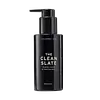What's inside
What's inside
 Key Ingredients
Key Ingredients

No key ingredients
 Benefits
Benefits

 Concerns
Concerns

 Ingredients Side-by-side
Ingredients Side-by-side

Sea Silt Extract
Skin ConditioningWater
Skin ConditioningDecyl Glucoside
CleansingSodium Lauroyl Lactylate
EmulsifyingGlycerin
HumectantSqualane
EmollientXanthan Gum
EmulsifyingGlyceryl Stearate
EmollientGluconolactone
Skin ConditioningParfum
MaskingSodium Lauroyl Oat Amino Acids
CleansingBenzyl Alcohol
PerfumingPotassium Sorbate
PreservativeSodium Benzoate
MaskingSaccharide Isomerate
HumectantVitis Vinifera Fruit Extract
Skin ConditioningEpilobium Angustifolium Extract
Skin ConditioningAchillea Millefolium Extract
CleansingUrtica Dioica Extract
AstringentCalcium Gluconate
HumectantZingiber Officinale Root Extract
MaskingBoswellia Serrata Resin Extract
SmoothingMaltodextrin
AbsorbentArnica Montana Flower Extract
MaskingVaccinium Myrtillus Leaf Extract
AstringentCalendula Officinalis Flower Extract
MaskingChamomilla Recutita Flower Extract
MaskingNelumbo Nucifera Leaf Extract
Skin ConditioningLactobacillus Ferment
Skin ConditioningCitric Acid
BufferingSodium Citrate
BufferingTriethyl Citrate
MaskingDimethylheptenal
PerfumingElettaria Cardamomum Seed Oil
MaskingJuniperus Communis Fruit Oil
MaskingJuniperus Virginiana Oil
MaskingMichelia Alba Leaf Oil
MaskingPelargonium Graveolens Flower Extract
Skin ConditioningSea Silt Extract, Water, Decyl Glucoside, Sodium Lauroyl Lactylate, Glycerin, Squalane, Xanthan Gum, Glyceryl Stearate, Gluconolactone, Parfum, Sodium Lauroyl Oat Amino Acids, Benzyl Alcohol, Potassium Sorbate, Sodium Benzoate, Saccharide Isomerate, Vitis Vinifera Fruit Extract, Epilobium Angustifolium Extract, Achillea Millefolium Extract, Urtica Dioica Extract, Calcium Gluconate, Zingiber Officinale Root Extract, Boswellia Serrata Resin Extract, Maltodextrin, Arnica Montana Flower Extract, Vaccinium Myrtillus Leaf Extract, Calendula Officinalis Flower Extract, Chamomilla Recutita Flower Extract, Nelumbo Nucifera Leaf Extract, Lactobacillus Ferment, Citric Acid, Sodium Citrate, Triethyl Citrate, Dimethylheptenal, Elettaria Cardamomum Seed Oil, Juniperus Communis Fruit Oil, Juniperus Virginiana Oil, Michelia Alba Leaf Oil, Pelargonium Graveolens Flower Extract
Water
Skin ConditioningSodium C14-16 Olefin Sulfonate
CleansingDisodium Cocoamphodiacetate
CleansingAloe Barbadensis Leaf Juice
Skin ConditioningCocamidopropyl Betaine
CleansingSodium Lauroyl Oat Amino Acids
CleansingGlycol Distearate
EmollientPEG-150 Distearate
EmulsifyingHamamelis Virginiana Extract
AntiseborrhoeicGlycerin
HumectantLavandula Angustifolia Extract
Skin ConditioningSalvia Officinalis Leaf Extract
CleansingMatricaria Recutita Flower Oil
PerfumingRosmarinus Officinalis Leaf Oil
MaskingSalvia Officinalis Leaf Oil
Lippia Citriodora Oil
PerfumingPEG-8 Dimethicone
EmulsifyingSodium Chloride
MaskingSodium PCA
HumectantCetyl Alcohol
EmollientCitric Acid
BufferingBenzyl Alcohol
PerfumingDehydroacetic Acid
PreservativeWater, Sodium C14-16 Olefin Sulfonate, Disodium Cocoamphodiacetate, Aloe Barbadensis Leaf Juice, Cocamidopropyl Betaine, Sodium Lauroyl Oat Amino Acids, Glycol Distearate, PEG-150 Distearate, Hamamelis Virginiana Extract, Glycerin, Lavandula Angustifolia Extract, Salvia Officinalis Leaf Extract, Matricaria Recutita Flower Oil, Rosmarinus Officinalis Leaf Oil, Salvia Officinalis Leaf Oil, Lippia Citriodora Oil, PEG-8 Dimethicone, Sodium Chloride, Sodium PCA, Cetyl Alcohol, Citric Acid, Benzyl Alcohol, Dehydroacetic Acid
Ingredients Explained
These ingredients are found in both products.
Ingredients higher up in an ingredient list are typically present in a larger amount.
Benzyl Alcohol is most commonly used as a preservative. It also has a subtle, sweet smell. Small amounts of Benzyl Alcohol is not irritating and safe to use in skincare products. Most Benzyl Alcohol is derived from fruits such as apricots.
Benzyl Alcohol has both antibacterial and antioxidant properties. These properties help lengthen the shelf life of products. Benzyl Alcohol is a solvent and helps dissolve other ingredients. It can also improve the texture and spreadability.
Alcohol comes in many different forms. Different types of alcohol will have different effects on skin. This ingredient is an astringent alcohol.
Using high concentrations of these alcohols are drying on the skin. They may strip away your skin's natural oils and even damage your skin barrier. Astringent alcohols may also irritate skin.
Other types of astringent alcohols include:
According to the National Rosacea Society based in the US, you should be mindful of products with these alcohols in the top half of ingredients.
Any type of sanitizing product will have high amounts of alcohol to help kill bacteria and viruses.
Learn more about Benzyl AlcoholCitric Acid is an alpha hydroxy acid (AHA) naturally found in citrus fruits like oranges, lemons, and limes.
Like other AHAs, citric acid can exfoliate skin by breaking down the bonds that hold dead skin cells together. This helps reveal smoother and brighter skin underneath.
However, this exfoliating effect only happens at high concentrations (20%) which can be hard to find in cosmetic products.
Due to this, citric acid is usually included in small amounts as a pH adjuster. This helps keep products slightly more acidic and compatible with skin's natural pH.
In skincare formulas, citric acid can:
While it can provide some skin benefits, research shows lactic acid and glycolic acid are generally more effective and less irritating exfoliants.
Most citric acid used in skincare today is made by fermenting sugars (usually from molasses). This synthetic version is identical to the natural citrus form but easier to stabilize and use in formulations.
Read more about some other popular AHA's here:
Learn more about Citric AcidGlycerin is already naturally found in your skin. It helps moisturize and protect your skin.
A study from 2016 found glycerin to be more effective as a humectant than AHAs and hyaluronic acid.
As a humectant, it helps the skin stay hydrated by pulling moisture to your skin. The low molecular weight of glycerin allows it to pull moisture into the deeper layers of your skin.
Hydrated skin improves your skin barrier; Your skin barrier helps protect against irritants and bacteria.
Glycerin has also been found to have antimicrobial and antiviral properties. Due to these properties, glycerin is often used in wound and burn treatments.
In cosmetics, glycerin is usually derived from plants such as soybean or palm. However, it can also be sourced from animals, such as tallow or animal fat.
This ingredient is organic, colorless, odorless, and non-toxic.
Glycerin is the name for this ingredient in American English. British English uses Glycerol/Glycerine.
Learn more about GlycerinWe don't have a description for Sodium Lauroyl Oat Amino Acids yet.
Water. It's the most common cosmetic ingredient of all. You'll usually see it at the top of ingredient lists, meaning that it makes up the largest part of the product.
So why is it so popular? Water most often acts as a solvent - this means that it helps dissolve other ingredients into the formulation.
You'll also recognize water as that liquid we all need to stay alive. If you see this, drink a glass of water. Stay hydrated!
Learn more about Water